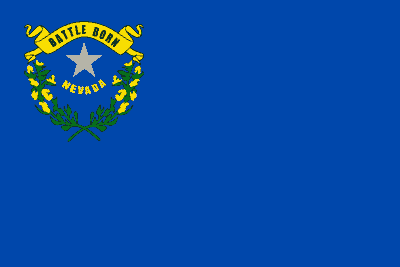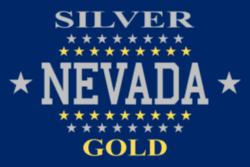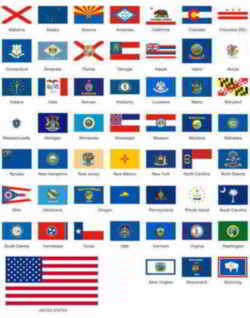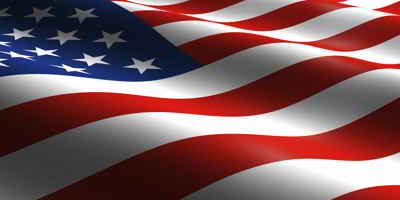Nevada State
Flag
Adopted in 1929.
The flag of the state of Nevada was adopted in 1929 and consists of a cobalt blue field with a silver star in the upper left hand corner, surrounded by the state name "Nevada." Above this is a golden-yellow scroll with the words "Battle Born," indicating that Nevada became a state during the American Civil War. Below the star are two sprays of green sagebrush (the state flower) with yellow flowers.
The Nevada State Flag
Unlike seals and mottoes that were devised early in Nevada's history, a state flag was not provided for until after the turn of the century. Also, unlike the state seal whose design has remained static, the basic design of the state flag has been changed significantly. Nevada's state flag has changed 3 times. A winning design by Louis Shellback gave this state its simple sprigs of sagebrush, the state flower, and a silver star, representing the famous Comstock Lode discovered in Nevada in 1859, one of the richest deposits of silver and gold ever found. Silver and gold are still the state colors.
Nevada State Flag of 1905 - 1915
In 1905, the legislature adopted a bill to provide the first official flag of the State of Nevada. It incorporated a design proposed by Governor John Sparks and Colonel Sylvester "Henry" Day, Assistant Adjutant General of the Nevada National Guard, both of whom believed a symbol was needed to honor Nevada's rejuvenated mining industry. This act provided the following specifications:
The flag of the State of Nevada will be of blue bunting, with the following devices thereon, to wit: The word "NEVADA" in silver-colored block letters, equidistant between the top and bottom, near the top the word "SILVER" in silver color, and near the bottom, the word "GOLD" in gold color, each of which shall be in Roman capital letters, and there shall be under the word "Silver" a row of eight stars in silver color; under which and above the word "Nevada" a row of nine stars in gold color, at each end of the word "Nevada" a silver-colored star, and under the word "Nevada" a row of nine stars in gold color, under which and above the word "Gold" a row of eight stars in silver color. Each star shall have five points and be placed with one point up.
It is possible that only one flag with this first design was produced. During the 1905 legislative session, a banner with the proposed design was kept in Governor Spark's office. At the Assembly's request, the flag was brought to the chambers for the members to examine. After the session ended, the Nevada National Guard purchased the flag from Governor Sparks for $30.65. The order for the purchase was issued by Adjutant General Lemuel Allen, who was also Lieutenant Governor at the time. (Mr. Allen had served in the Assembly from the 1889 Session through the 1901 Session and again in 1909.) In 1923, Colonel Henry Day donated this same banner to the Nevada Historical Society, which restored this valuable Nevada emblem in the early 1990s. No other flag of this design is known.
Nevada State Flag of 1915
Nevada's first flag had a legal lifespan of slightly over 10 years. In 1915, the Nevada Legislature repealed the 1905 Flag Act and created an official flag for the State of Nevada that was distinctly different in design. Specifications for the flag were as follows:
The body of the flag shall be of solid blue. On the blue field, and in the center thereof shall be placed the great seal of the State of Nevada, as the same is designed and created, by section 4402, Revised Laws, 1912; the design of said seal to be in scroll border, and the words "The Great Seal of the State of Nevada" to be omitted. Immediately above the seal shall be the words "Nevada," in silver-colored block Roman capital letters. Immediately below the seal, and in the form of a scroll, shall be the words "All For Our Country," in gold-colored block Roman capital letters. Above the words "Nevada" there shall be placed a row of eighteen gold-colored stars, and below the words "All For Our Country" there shall be placed a row of eighteen silver-colored stars. Each star shall have five points, and shall be placed with one point up.
This second official banner was designed by Clara M. Crisler, a Carson City native and enrolling clerk for the Assembly during the 1921 and 1923 sessions. Again, few flags were actually produced. On July 19, 1924, The Eureka Sentinelreported that two Nevada flags were on display at the General Federation of Women's Clubs in Los Angeles, California, which was probably due to Ms. Crisler's long and active participation in the Nevada Federation of Women's Clubs. These flags were borrowed from the Governor's office and appeared to be the only ones in the state at that time. An additional banner was flying on the battleship USS. Nevada.
Nevada State Flag of 1929
The third official flag for Nevada was created by an act of the legislature in 1929. A movement to change the flag yet again began on June 15,1926, when Nevada Lieutenant Governor Maurice J. Sullivan had notices published in several Nevada newspapers announcing a contest for a new design for the official state flag. The notices indicated that the 1915 design was expensive to reproduce because it required 30 to 40 different color shades and was difficult to distinguish from many other states' flags. Mr. Sullivan offered a $25 prize for the design chosen by a committee; however, he noted that the honor of having one's design chosen would outweigh the monetary award. Contestants could enter as many designs as they wanted and could submit descriptions of the designs; drawings were not necessary. The contest ran until October 10, 1926.
Early in 1927, each house of the Nevada Legislature appointed members to serve on a committee to select a design for the state flag. On January 27, 1927, Assemblyman Frank H. Winter announced the selection of a design by "Don" Louis Schellbach, III, a state employee, out of hundreds submitted. At the time, it was planned that a flag with the winning composition would be flown at the upcoming inaugural ball.
The 1927 legislature, however, did not consider a bill to establish a new state flag, as had been Mr. Sullivan's original intention.
On February 19, 1929, Senate Bill 51, creating a state flag using the design chosen in 1927, was introduced by Senator William F. Dressler. The measure passed the Senate without amendment and was sent to the Assembly.
Mr. Schellbach's design did not contain the word "Nevada" This omission was noticed by the 1929 legislature, and Assemblyman Cada C. Boak supplied the missing word through the amendment approved by the Assembly. The amendment placed the word in a circle around the single star provided for in the design, specifically stating that "Nevada" would begin at the upper point of the star with the letter "N," followed by the other letters "equally spaced between the points of the star"
Despite Mr. Sullivan's contest and the action by the 1929 legislature, the new flag received little immediate attention. The Sparks Tribunenoted on April 24, 1936, that the USS. Nevadastill carried the 1915 flag and that, in fact, the new flag was practically unknown because less than six flags existed at that time, seven years after the legislation was enacted.
In 1935, the Nevada State Flag Association was formed in response to the lack of flags. The Association enlisted the American Legion of the state to provide monetary support and needlewomen of the Works Project Administration (WPA) to hand-make the flags. In 1937, a new flag was presented to the battleship, and by 1939, new flags had been produced for the University of Nevada and the Governor's Office.
Don Schellbach, the state flag's designer, left Nevada to work at the Museum of the American Indian in New York City in May 1927. Known as "Mr. Grand Canyon" when he died on September 22, 1971 in Tucson at the age of 83, he had worked for more than 24 years for the National Park Service at Grand Canyon.
In November 1989, Nevada legislative researcher Dana Bennett discovered a clerical error in the flag's legislation of 60 years earlier. That error compromising legislative intent was independently substantiated by State Archives and Records Administrator Guy Rocha after examining legislative records in the State Archives. The Assembly did amend the bill to place the word "Nevada" around the star, but the Senate refused to concur in that amendment. A conference committee was established on March 19 and reported back on March 20, 1929. On March 21,1929, the last day of the session, both houses adopted the committee report, which did notplace "Nevada" in a circle. Instead, the committee agreed on the following sentence: "The word 'Nevada' shall also appear immediately below the sprays in silver Roman letters to conform with the letters appearing in the words 'Battle Born.'"
Yet, the language of the report was somehow omitted from the copy of the hill signed by the leaders of the Senate and Assembly and approved by the Governor. Consequently, the conference committee's agreement did not appear in the appropriate chapter of Statutes of Nevada 1929 nor in the corresponding section of NRS; thus, every state flag produced after the session was not in the design approved by the Nevada Legislature.
In 1991, due to finding this mistake, the Nevada Legislature changed the placement of the word "Nevada" on the state flag. The members chose to keep the word "Nevada" intact, as did the 1929 conference committee, but placed it above the sprays and in gold. The earlier action placed the word below the sprays and in silver. The following is the description of the flag currently provided by NRS 235.020:
The body of the flag shall be of solid cobalt blue. On the field in the upper left quarter thereof shall be two sprays of sagebrush with the stems crossed at the bottom to form a half wreath. Within the sprays must be a five-pointed silver star with one point up. The word "Nevada" must also be inscribed below the star and above the sprays, in a semicircular pattern with the letters spaced apart in equal increments, in the same style of letters as the words "Battle Born." Above the wreath, and touching the tips thereof shall be a scroll bearing the words "Battle Born." The scroll and the word "Nevada" shall be golden-yellow. The lettering on the scroll must he black-colored sans serif gothic capital letters.
Only once has a proposed state flag design failed. In the closing days of the 1953 session, Senate Bill 231, which proposed a radically different design for the banner, was introduced and passed by both houses of the legislature and sent to the Governor. According to Reno's Nevada State Journal the measure was promoted by the Elko, Reno, and Las Vegas Chambers of Commerce who complained that the existing flag was too expensive to manufacture and, therefore, many Nevada organizations could not afford to display it. The proposal would cut the manufacturing cost from $20 to around $7 for each flag. The description of the 1953 flag was as follows:
The body of the flag shall be in three equal vertical stripes, consisting of one ultramarine blue stripe next to the staff or halyard hem, a central stripe of pure white, and an outer stripe of silver grey. Upon the vertical centerline of the white stripe shall be centered a solid red silhouette of the State of Nevada, extending from a distance below the top of the flag equal to one-sixth of the vertical width of the flag, to a distance from the bottom border of the flag equal to one third of the vertical width of the flag. Within the silhouette of the State of Nevada shall be inscribed in white block capital letters the words "Battle Born" in two lines contained within the upper half of the State representation. Height of the letters shall be equal to one-seventh of the height of the State representation. Within the lower portion of the center white stripe there shall be further inscribed the word "Nevada" in red block capital letters, centered upon the vertical center-line of the white stripe, the letters to be equal in height to one-seventh of the vertical width of the flag placed with the base of the letters at a distance from the bottom border of the flag equal to one half the height of the letters in the word "Nevada."
However, Governor Charles H. Russell vetoed the bill. His message stated that the 1929 flag, "while, probably, ...not an adequate display symbol for the State, ...has a dignity which is not found in the proposed flag. Furthermore, it is my considered judgment that the proposed flag is not symbolic of Nevada." Governor Russell suggested that any new banner be proposed by a commission that conducts "a careful study made to embody true Nevada tradition into [the flag's] meaning." By the time the 1955 session convened, the earlier support for the new flag had evaporated, and the legislature sustained the veto.
The current Nevada State Flag design was adopted March 26, 1929, and revised in 1991. On a cobalt blue background in the upper left quarter is a five-pointed silver star between two sprays of sagebrush crossed to form a half wreath; across the top of the wreath is a golden scroll with the words, in black letters, "Battle Born." The name "Nevada" is beneath the star in gold letters.
Nevada State Flag
Nevada Revised Statutes, Title 19, Section 235.020
TITLE 19-MISCELLANEOUS MATTERS RELATED TO GOVERNMENT AND PUBLIC AFFAIRS.
STATE EMBLEMS; GIFTS AND ENDOWMENTS
STATE SEAL AND MOTTO
SECTION 235.020.
NRS 235.020 State flag.
The official flag of the State of Nevada is hereby created. The body of the flag must be of
solid cobalt blue. On the field in the upper left quarter thereof must be two sprays of sagebrush
with the stems crossed at the bottom to form a half wreath. Within the sprays must be a five-pointed
silver star with one point up. The word "Nevada" must also be inscribed below the
star and above the sprays, in a semicircular pattern with the letters spaced apart in equal
increments, in the same style of letters as the words "Battle Born." Above the wreath,
and touching the tips thereof, must be a scroll bearing the words "Battle Born."
The scroll and the word "Nevada" must be golden-yellow. The lettering on the scroll
must be black-colored sans serif gothic capital letters.
[1:147:1929; NCL § 7020]-(NRS A 1991, 773)

The Flags of the US.







